Harnessing the Power of Data Analytics and Generative AI: Transforming Decision-Making
This blog discusses the intersection of data analytics and generative AI, emphasizing their role in improving decision-making, enhancing data storytelling, and addressing ethical concerns in the AI landscape.
Picture a world where data drives every critical decision you make at work. The secret lies in understanding how to leverage data analytics and generative AI effectively. Let me share a little story: once, I was involved in a project where data cleaning took more time than analyzing the data itself. It was a nightmare! But what I learned during that process transformed how I approached data. Now, let’s dive deep into how you can harness these technologies to not only avoid the pitfalls I experienced but also elevate your decision-making processes to new heights!
Understanding Data Analytics: The Foundation of Informed Decisions
What is Data Analytics?
At its core, data analytics is the science of analyzing raw data to make conclusions about that information. It’s essential for discerning trends, making predictions, and ultimately, for decision-making in any organization. You may wonder, why is this so important? The answer is simple: in today’s digital age, data is everywhere, and leveraging it effectively can lead to significant advantages.
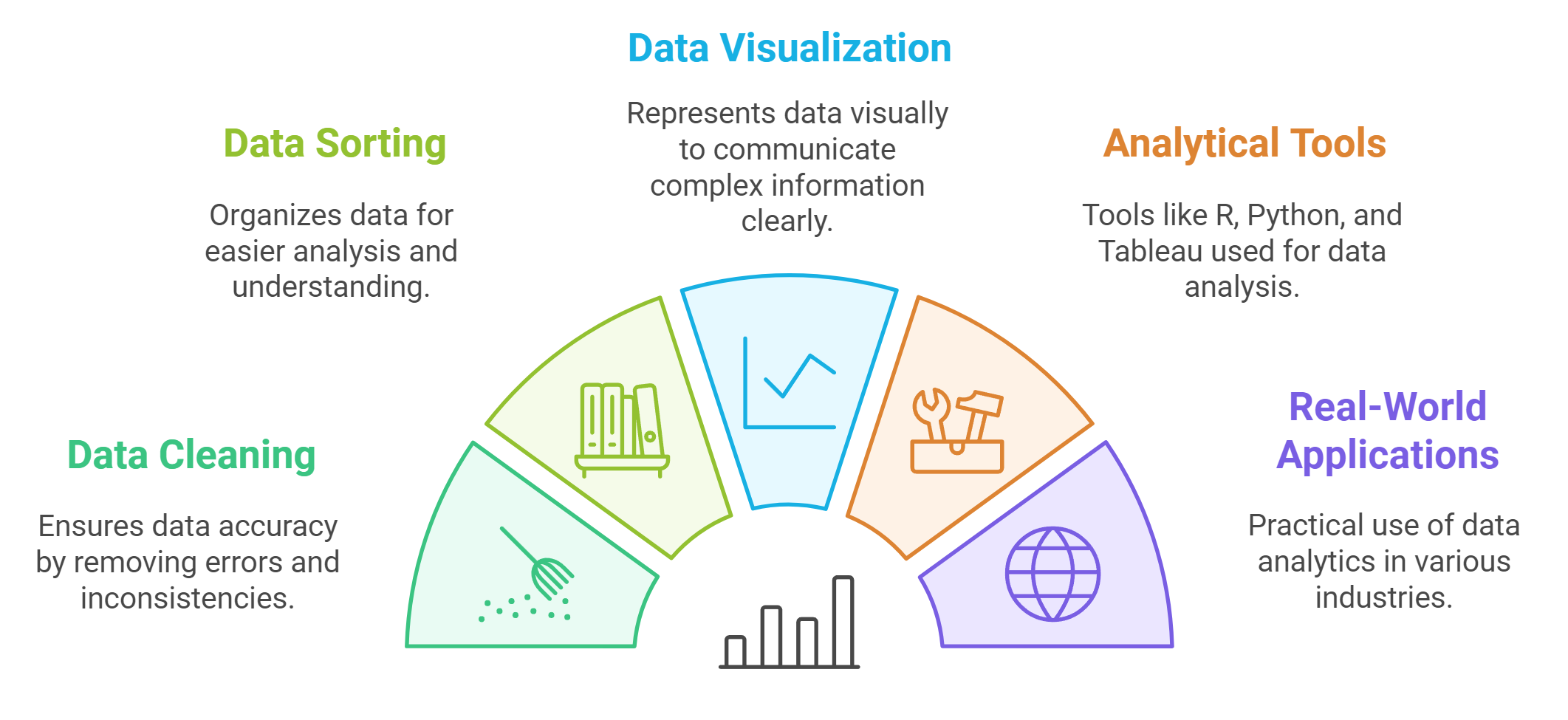
To put it another way, think of data as a treasure chest. Without a map, you can’t find what you’re looking for. Data analytics is your map; it guides you through mountains of information to uncover valuable insights.
The Key Processes in Data Analytics
In the world of data analytics, there are several key processes that stand out:
Data Cleaning: This involves removing errors and inconsistencies from your data. Bad data can lead to wrong conclusions. Effective cleaning ensures you’re working with accurate, high-quality data.
Data Sorting: Once you clean your data, sorting it is crucial. This organizing process helps you categorize information for easier analysis and understanding.
Data Visualization: This refers to representing data in a visual context, like charts or graphs. Visuals help to communicate complex information clearly. Think of it as painting a picture from your data!
Common Tools Used in Data Analytics
You might be curious about the tools used in data analytics. Here are some widely recognized options:
R: A programming language specifically designed for statistical computing and graphics. It’s very popular in academia and industry alike.
Python: Known for its versatility and ease of use, Python is ideal for data analysis and machine learning tasks.
Tableau: This software helps you visualize your data and share insights across your organization or with clients.
Each tool has its strengths, and often, data professionals use a combination to get optimal results. For instance, you could clean your data in Python and then visualize it in Tableau.
Real-World Applications of Data Analytics
Data analytics isn’t just theoretical. It has tremendous real-world applications, affecting various industries:
Retail: Companies like Target and Walmart use data analytics to understand customer behavior. This helps them to plan inventory and personalize marketing strategies.
Healthcare: In healthcare, analysts utilize data to make predictive models for patient outcomes. This can save lives and resources.
Finance: In finance, firms apply analytics for risk assessment and fraud detection, ensuring safer transactions.
These examples illustrate the versatility and necessity of data analytics in enhancing operational efficiency across multiple sectors.
The Role of Data Analytics in Business Decision-Making
Now, let’s dive into how data analytics impact business decisions. Organizations that integrate data analytics into their strategies are often more successful. By making informed decisions based on data, you minimize risks and maximize opportunities.
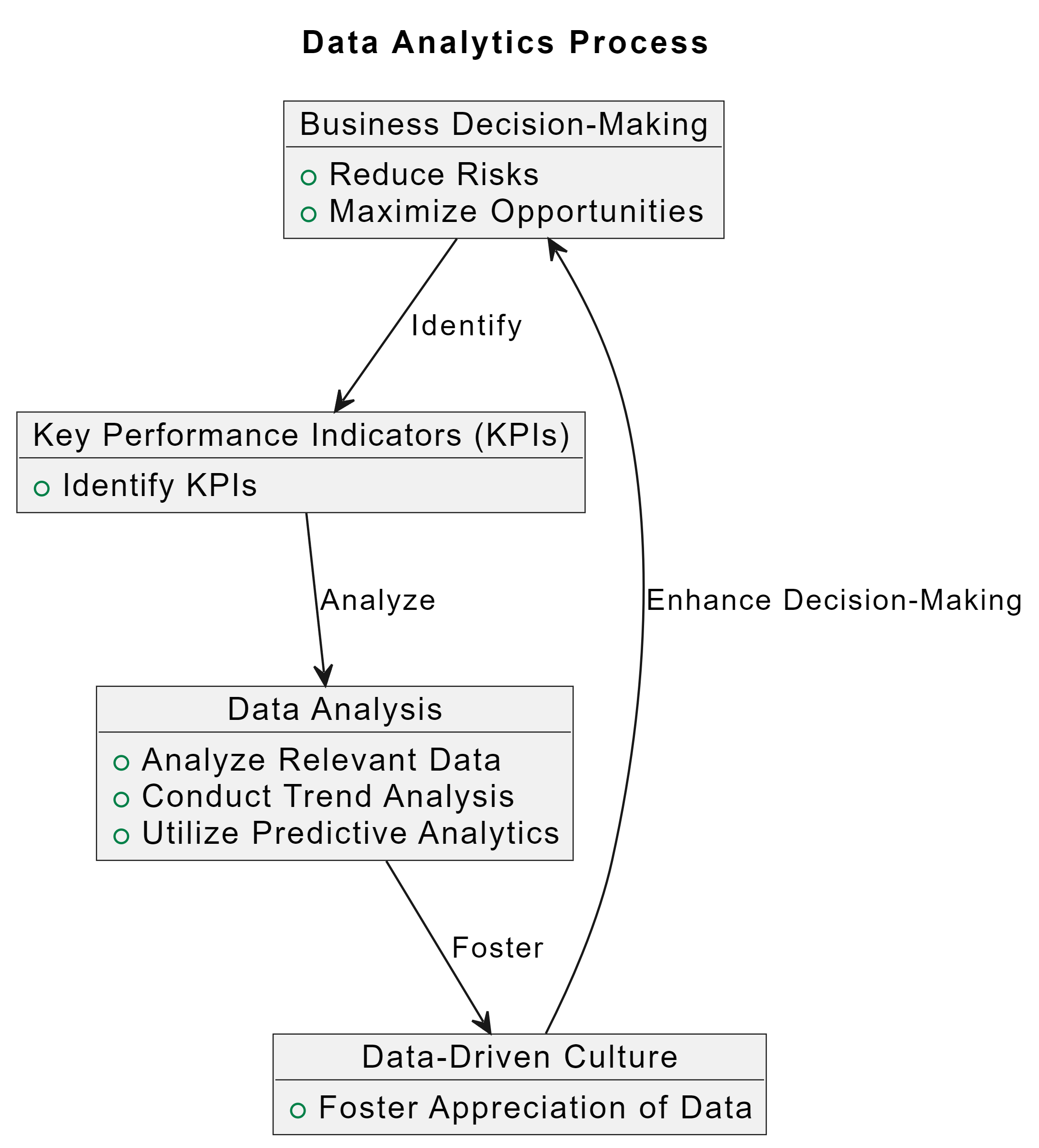
Data analytics significantly enhances business decision-making by reducing risks and maximizing opportunities. Organizations successfully implement analytics by identifying Key Performance Indicators (KPIs) and analyzing relevant data, conducting trend analysis to uncover patterns, and utilizing predictive analytics to forecast future outcomes. Additionally, fostering a data-driven culture ensures all team members appreciate the importance of data in decision-making. As Mike Pendleton noted, “people lie, but the data never does,” emphasizing the reliability of data when interpreted correctly.
You might ask, how do businesses actually implement data analytics in decision-making? Here’s how:
Identifying Key Performance Indicators (KPIs): Organizations determine which metrics matter most to their success and analyze data relevant to those KPIs.
Trend Analysis: Look for patterns within the data that can inform future decisions, such as buying trends or customer preferences.
Predictive Analytics: Use historical data to predict future outcomes. For example, businesses can forecast sales and adjust strategies accordingly.
Data-Driven Culture: Lastly, successful companies foster a culture that values data. Everyone—from leadership to team members—should understand the importance of data in driving decisions.
In this realm, Mike Pendleton, a thought leader in the industry, stated, “people lie, but the data never does.” This highlights that data, when interpreted correctly, provides a reliable foundation for decision-making.
Once More, the Importance of Data to Your Decisions
So, in summary, understanding data analytics is more than just learning tools—it’s about cultivating a mindset. You’re encouraged to think critically about data and its implications. As you navigate this field, remember that the practices of data cleaning, sorting, and visualization all converge into a powerful toolkit that can transform your decision-making.
Embrace the collaboration among various data tools, understand real-world applications, and feel empowered knowing that informed decisions lead to growth. Whether you're in marketing, finance, healthcare, or any other field, grasping the basics and importance of data analytics will enhance your capability to make lasting impacts.
Ultimately, data analytics isn’t just a skill set. It’s a gateway to innovation, allowing you to move forward confidently. So gear up; let data analytics pave the way toward informed decisions!
Generative AI: The Game-Changer in Data Processing
What is Generative AI?
Generative AI is an exciting and rapidly evolving field. At its core, it's a type of technology designed to create content. Imagine a program that can write a story, draw a picture, or even compose music. This isn’t just automation; it's about creating something new. The evolution of generative AI has been astounding. It’s gone from simple algorithmic processes to complex systems that can generate human-like responses and high-quality content. Just think about it: what was once a tool for data analysis has now become an artist, a writer, and much more.
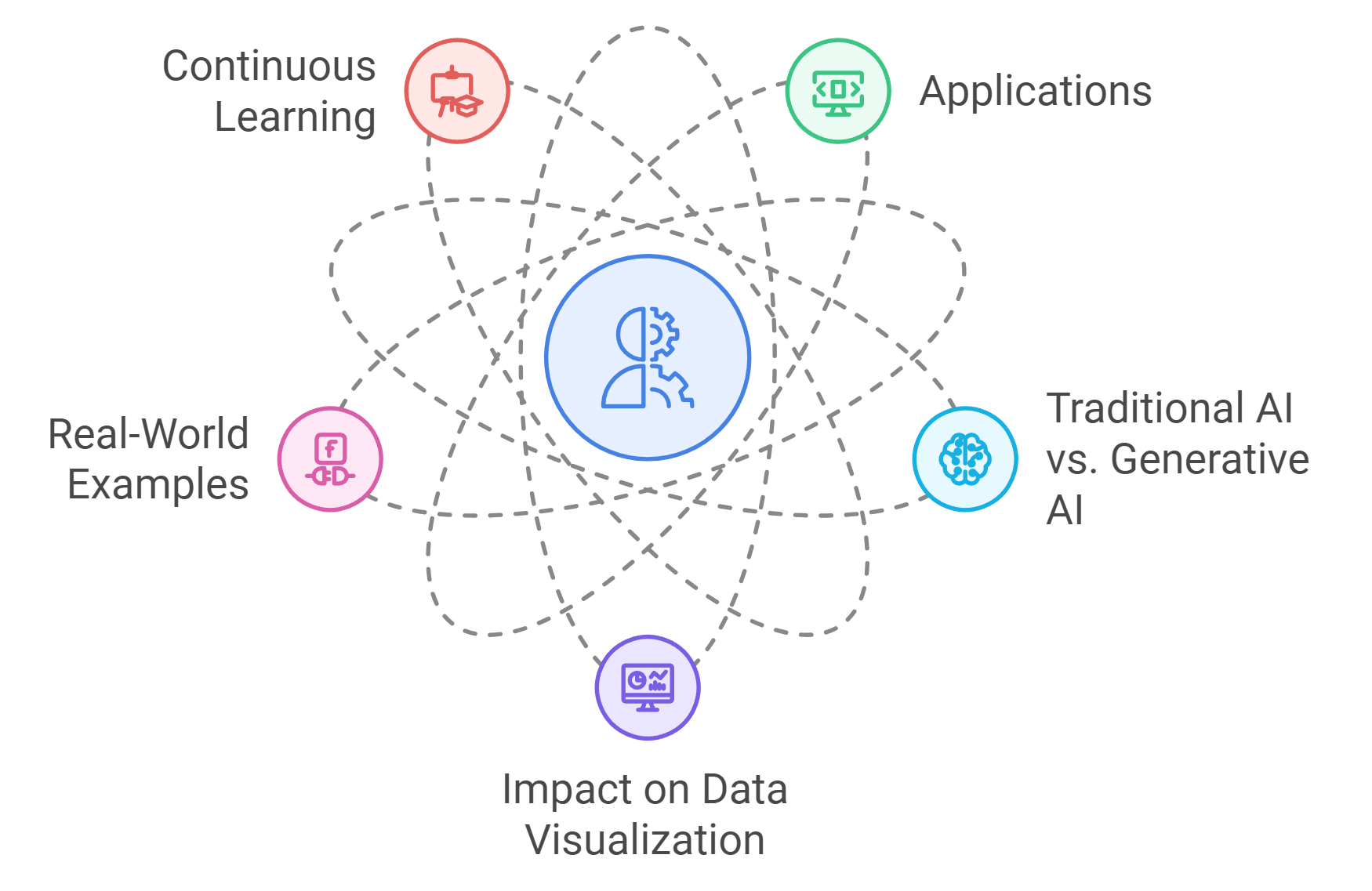
Where is it Applied?
The applications for generative AI are diverse. You might be surprised to learn that it’s used across multiple industries including:
Marketing: Crafting personalized advertisements that appeal directly to potential customers.
Healthcare: Creating synthetic datasets to assist with patient diagnosis.
Entertainment: Generating scripts, stories, and even game designs.
Logistics: Optimizing supply chain processes and predicting demand patterns.
These industries thrive on creative content and data-driven insights. Generative AI is a key player in pushing these boundaries further.
Traditional AI vs. Generative AI
So, what's the difference between traditional AI and generative AI? Traditional AI systems are often rule-based. They perform tasks from a fixed set of instructions. This means they analyze data and follow scripts to provide solutions. They can't create new content; they can only rearrange or process existing information.

On the other hand, generative AI doesn’t just analyze and respond. It synthesizes information. Picture a chef creating a new dish. Rather than just following a recipe, a generative AI "chef" combines various ingredients (data) to invent something entirely original. This ability to generate new insights and content is what sets generative AI apart.
Impact on Data Visualization
Data visualization has undergone a transformation thanks to generative AI. In the past, creating visuals required significant expertise and manual effort. Today, AI-driven tools can automate this process. Thanks to these advancements, tools like Tableau and Power BI allow businesses to visualize complex data in real-time. Imagine receiving immediate insights about customer behavior. It’s like having an assistant who can instantly find the most important trends in a sea of numbers.
Moreover, as Mike Pendleton pointed out, the future may hold even more interactive, voice-controlled visualizations. This means you could ask your system to show you trends and automatically generate insightful dashboards, making data easier to understand.
Real-World Company Examples
What does this look like in practice? Companies are harnessing the power of generative AI in remarkable ways.
Target and Walmart: These retail giants use AI-driven tools to visualize customer behavior. They rely on real-time data analysis to make strategic decisions.
JPMorgan Chase: This financial institution employs AI-powered tools for data cleaning, making the process efficient and less error-prone.
Healthcare Providers: Many hospitals use synthetic datasets created by generative AI to improve patient outcomes. This technology assists in forming better treatment plans based on predictive analysis.
These organizations exemplify the practical integration of generative AI into their operational frameworks. They're not just using it casually; they are embedding it deeply into their strategies for immense impact.
Generative AI and Continuous Learning
Finally, it’s essential to emphasize the need for continuous learning in the field of AI. As Mike Pendleton mentioned, learning should never be an endpoint. Institutions and organizations need to promote environments where employees can gain insights and enhance their skills. Joining communities, engaging with platforms like NVIDIA’s Deep Learning Institute, and immersing yourself in coding practices could pave the way for improvement in this field.
Think of generative AI like a river. It's ever-flowing and always changing. You have to keep dipping your toes in to stay current.
Generative AI isn't just reshaping how we interact with data. It's redefining the way content is created and presented. As you dive into this technology, remember that you're part of something transformative.
The Synergy Between Data Analytics and Generative AI
In today’s fast-paced digital landscape, the fusion of data analytics and generative AI is reshaping how businesses operate. This synergy isn't just a buzzword; it’s a powerful approach to enhancing business operations and driving smarter decision-making. But how exactly does this integration lead to better outcomes? Let’s unravel the complexities and discover the potential.
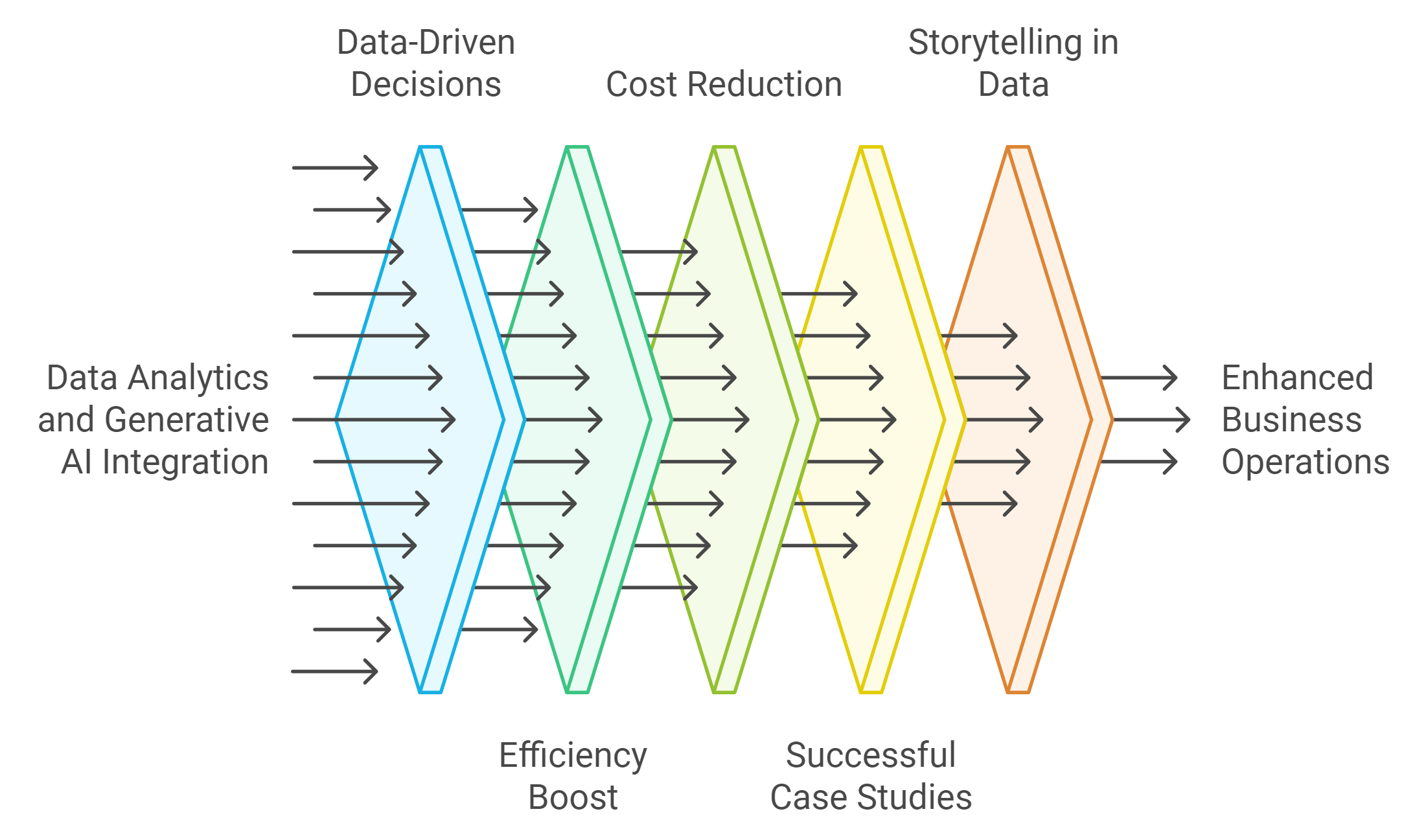
1. How Integrative Approaches Enhance Business Operations
Integrative approaches combine the strengths of data analytics and generative AI, creating innovative paths for improvement. Think of it as mixing two different yet complementary ingredients to enhance a recipe. Here's what happens:
Data-Driven Decisions: By analyzing historical data, businesses can identify patterns. Generative AI can then simulate future scenarios based on this data.
Efficiency Boost: Automation through generative AI can optimize tedious tasks, freeing up time for employees to focus on strategy.
Cost Reduction: Automating data processing lowers operational costs and reduces the chance of human error.
For instance, consider retailers like Walmart, which utilize generative AI alongside data analytics to predict inventory needs more accurately. This orchestrates a seamless flow of goods, minimizing waste and improving customer satisfaction. The result? A noticeably enhanced bottom line.
2. Examples of Successful Case Studies
Success stories abound when combining data analytics with generative AI. These examples illustrate real-world applications:
Healthcare Revolution: In the healthcare sector, generative AI helped create a synthetic dataset for a pharmaceutical company. This dataset proved crucial for their clinical trial designs, demonstrating the power of this technology to fill knowledge gaps.
Financial Sector Transformation: JPMorgan Chase employs AI-powered tools to clean data. This process minimizes manual entry errors, resulting in faster, more reliable reports.
Marketing Enhancements: Companies like Target use generative AI to produce personalized marketing campaigns based on customer behavior analytics. This tailored approach results in higher engagement and increased sales.
These case studies underscore a key point: when organizations embrace both technologies, they position themselves ahead of the curve in their respective industries.
3. Importance of Storytelling in Data-Driven Narratives
Storytelling is crucial in data analytics. But why does it matter?
Consider the sheer volume of data we generate daily. Without a compelling narrative, insights can become lost in the noise. Storytelling makes data relatable, engaging, and easier to understand. When you present data through stories, it creates a connection.
Make It Accessible: Visual storytelling can simplify complex data sets, turning numbers into relatable experiences.
Enhance Engagement: Using narratives keeps your audience interested, allowing them to see the relevance of the data in their own lives.
Drive Action: Stories motivate stakeholders to act on insights. A compelling story around customer data can drive strategic decisions.
4. Balancing Human Insight with Automation
As businesses increasingly lean on AI for tasks, a balance must be struck between human insight and automation. But how do you achieve this equilibrium?

While technology can process data at lightning speed, it lacks the nuanced understanding only humans possess. Here’s how to balance both:
Emphasize Collaboration: Encourage teams to work with AI tools. Relying solely on automation can overlook critical insights that require human judgment.
Train and Upskill: Invest in continual learning for your workforce. Familiarizing them with these tools ensures they can leverage technology while providing valuable input.
Define Clear Roles: Clarify the limits of automation. Understanding where human insight is irreplaceable is key to effective strategy.
By striking this balance, businesses harness collective power, combining efficiency with the creativity and intuition that only humans bring.
5. Future Predictions: Where Will This Synergy Lead?
As we look ahead, the future is brimming with possibilities. The synergy between data analytics and generative AI is poised to evolve in exciting ways. Here are some predictions:
Hyper-Personalization: Imagine data narratives tailored to each user’s preferences. As AI progresses, businesses will create hyper-personalized experiences, making every interaction feel unique.
Smarter Decision Making: Integrated systems will analyze vast datasets and provide actionable insights. The decision-making process will become increasingly swift and efficient.
Interactive AI: Future AI tools may allow for real-time interaction with data visualizations. This could transform how businesses present and interpret data.
In this rapidly evolving landscape, are you prepared to embrace the future? The partnership between data analytics and generative AI isn’t just a trend; it’s the foundation for business innovation moving forward.
Ultimately, companies that invest in understanding and using this synergy will lead the way in their industries. The journey into this new frontier is just beginning, and it’s filled with opportunities for growth and transformation.
Navigating Ethical Considerations in AI Implementation
Identifying Potential Biases in AI Systems
Have you ever wondered how biases can creep into AI systems? It's a crucial question. AI doesn’t think like us. Instead, it learns from data. If that data is biased, guess what? The AI will also be biased. Studies show that many facial recognition systems struggle to identify individuals of different races. This is a clear example of bias in AI.

Understand the sources of bias: Data collection methods, societal influences, and the models themselves can introduce bias.
Evaluate your datasets: Regular audits can uncover hidden biases.
Engage with diverse teams: A range of perspectives can help identify potential blind spots.
And that’s not all. Bias in AI can lead to significant ethical issues, like unfair treatment and discrimination. This is not just a tech problem, but a societal one. So, how do we tackle these biases effectively?
Maintaining Data Privacy and Security
Securing data is not a luxury; it’s a necessity. With the rise of AI, there’s a greater risk of data breaches. The question is, how do you protect this sensitive information?
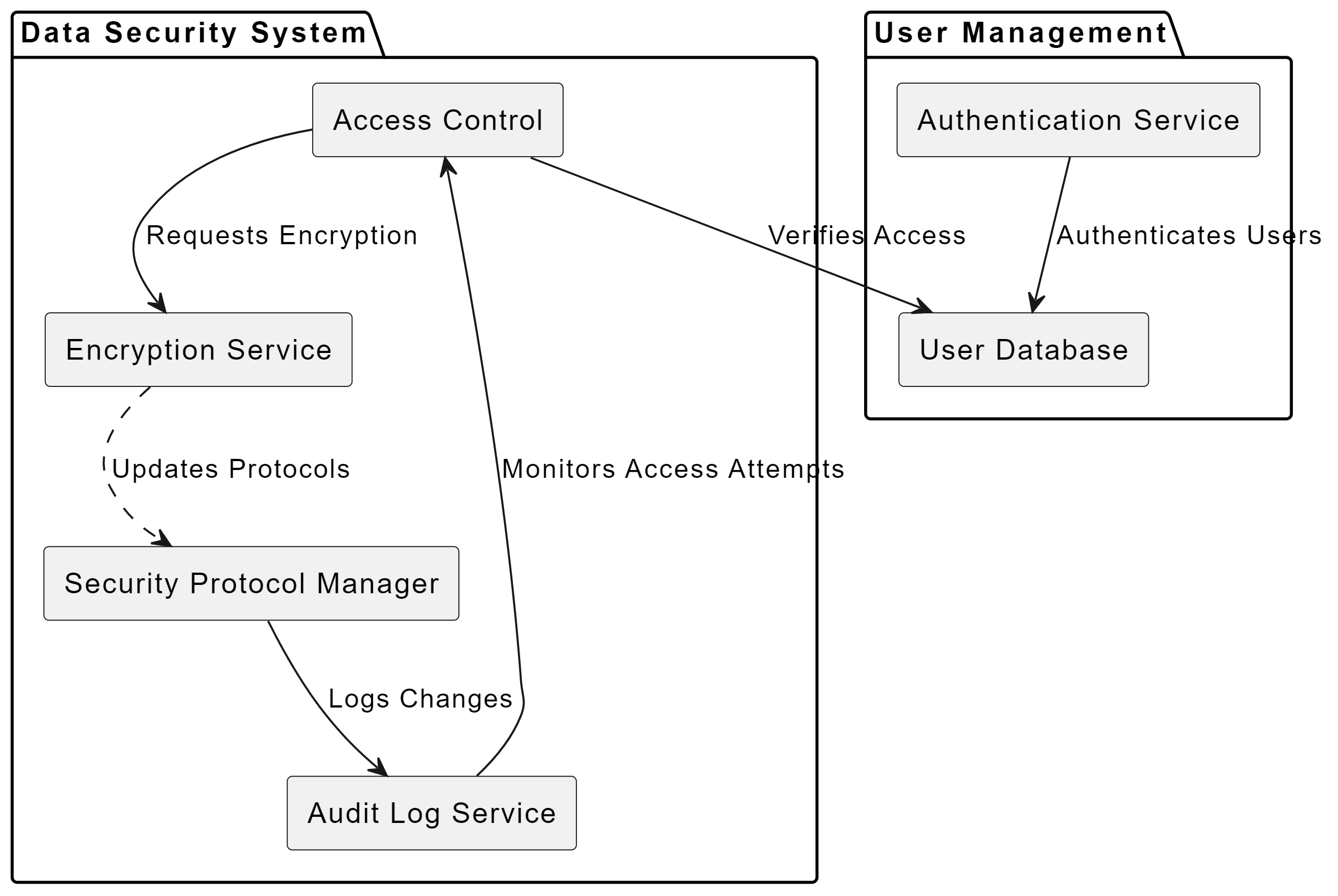
Implement strict access controls: Only authorized personnel should have access to sensitive data.
Utilize encryption: Encrypting data can protect it from unauthorized access.
Regularly update security protocols: Keep abreast of the latest cybersecurity threats.
“People lie, but the data never does,”
said Mike Pendleton, founder of AI Cowboys. This quote emphasizes the importance of not just collecting data, but protecting it.
Regulatory Frameworks Governing AI Use
Have you heard of regulatory frameworks related to AI? These are essential for guiding the ethical use of AI technologies. Laws vary by country, but many countries are beginning to enact regulations around AI, like GDPR in Europe.
Understand existing regulations: Familiarize yourself with the laws applicable in your region.
Ensure compliance: Regular assessments can help your organization stay compliant.
Engage in policy conversations: Join discussions on ethical AI use within your industry.
The role of regulatory frameworks is to protect individuals while allowing innovation. Balancing these aspects is no easy task. Are we stifling creativity in pursuit of ethics?
Case Studies of Ethical Challenges in AI
Learning from real-world examples can be beneficial. Take the infamous data poisoning incident. In this scenario, attackers manipulated training data to bias an AI system—a stark reminder of the vulnerabilities AI can face.
Data poisoning: This involves injecting malicious data, leading the AI to learn incorrect information.
Bias in NLP models: Natural Language Processing models have been known to perpetuate harmful stereotypes.
Real-life impacts: The implications of these challenges extend to social justice and individual rights.
How often do you think about the unintended consequences of AI technologies? Most people don’t until it’s too late. Ethical challenges in AI are not just technical issues; they're deeply human issues.
Best Practices for Ethical Usage of AI Technologies
When working with AI, you can adopt certain best practices to ensure ethical use. What are these practices?
Develop ethical guidelines: Establish a framework for ethical decision-making within your organization.
Foster transparency: Be open about how your AI systems operate and how decisions are made.
Encourage feedback: Create channels for users to report issues they encounter.
Invest in training: Ensure your team is educated on ethical AI practices and the latest laws.
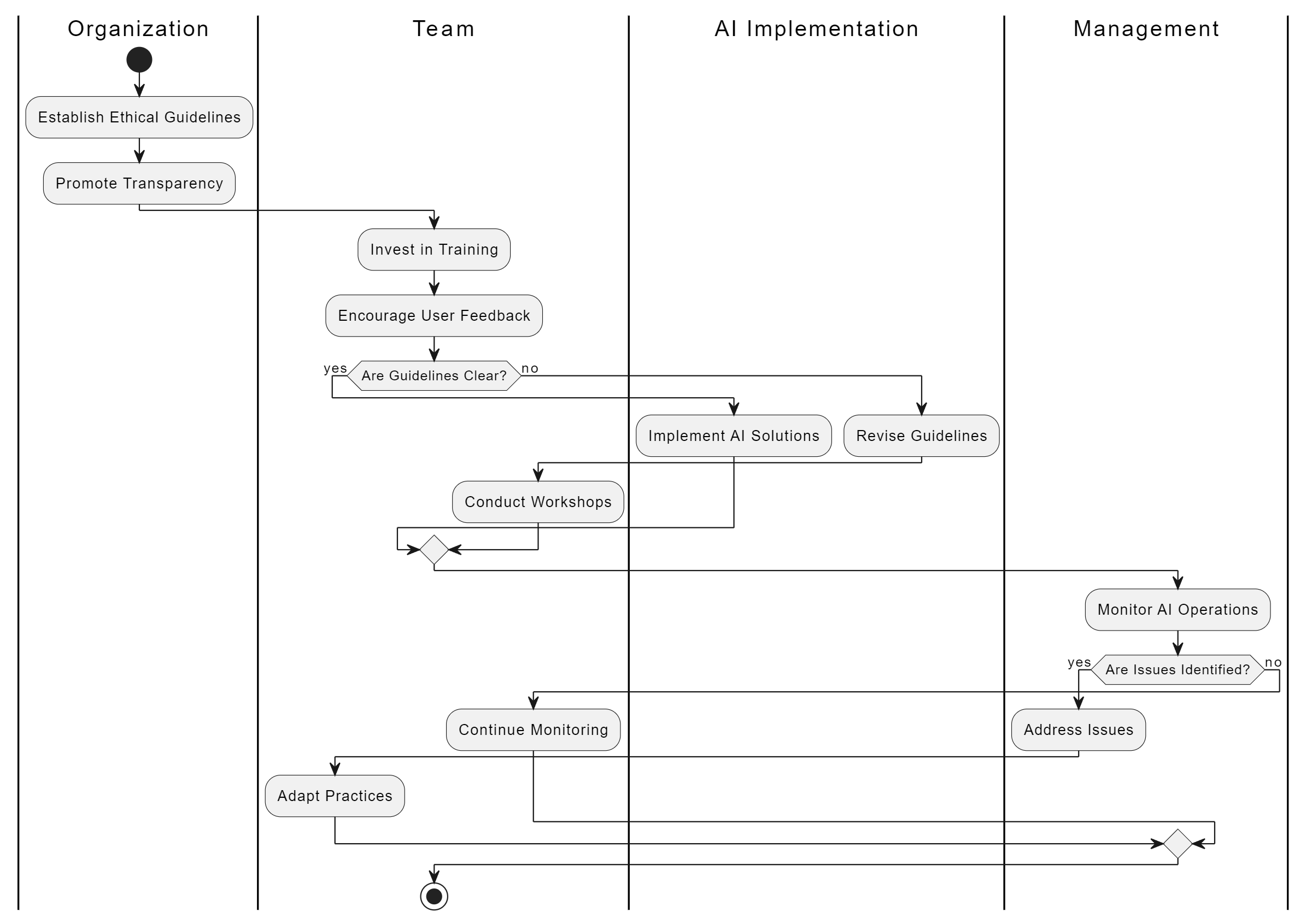
Ultimately, maintaining an ethical approach requires constant vigilance. Are your practices set in stone? Or are you being flexible and adapting as the technology evolves? The field of AI is continually changing, much like the ethical landscape surrounding it.
In the End
Every decision you make in AI implementation carries weight. From understanding biases to ensuring data security and navigating regulatory challenges, the road is fraught with complexities. But with the right practices, you can navigate these ethical considerations carefully.
Future Trends: The Next Steps in Data and AI Integration
As we dive into the future of data and AI integration, you might wonder: what lies ahead? The evolution of technology has reshaped our understanding and application of data. With trends like predictive analytics and self-service tools emerging, businesses are adapting rapidly. So, let’s explore these exciting developments.
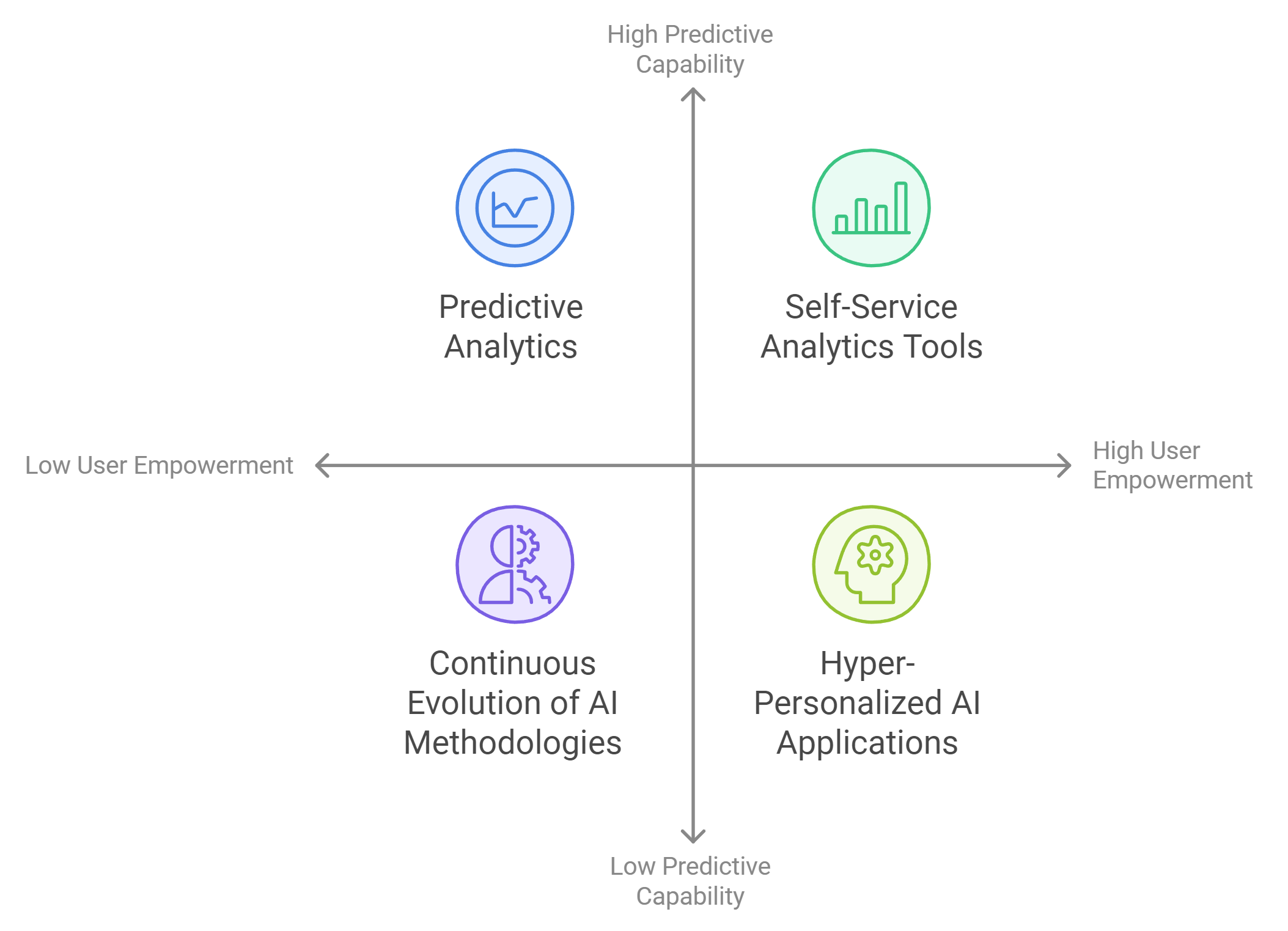
1. Predictive Analytics: The Future in Data Forecasting
Predictive analytics is changing the game. It refers to techniques that use historical data to predict future outcomes. Think of it as having a crystal ball, only better. Imagine a sales team using historical customer data to forecast sales trends. They can make informed decisions instead of guessing.
Consider some critical aspects:
Data Patterns: Predictive analytics identifies patterns in data. This helps businesses create strategies.
Risk Management: Companies can foresee potential challenges and mitigate risks by predicting future trends.
Customer Insights: Personalization improves as businesses understand customer behavior.
Isn’t it fascinating how businesses will become more proactive rather than reactive? With advanced predictive tools, companies aim to stay one step ahead.
2. The Rise of Self-Service Analytics Tools for Businesses
Self-service analytics tools empower users to analyze data without needing deep technical knowledge. This democratizes data access. No more waiting for the IT department to run reports. You can visualize your own data, create dashboards, and generate insights.
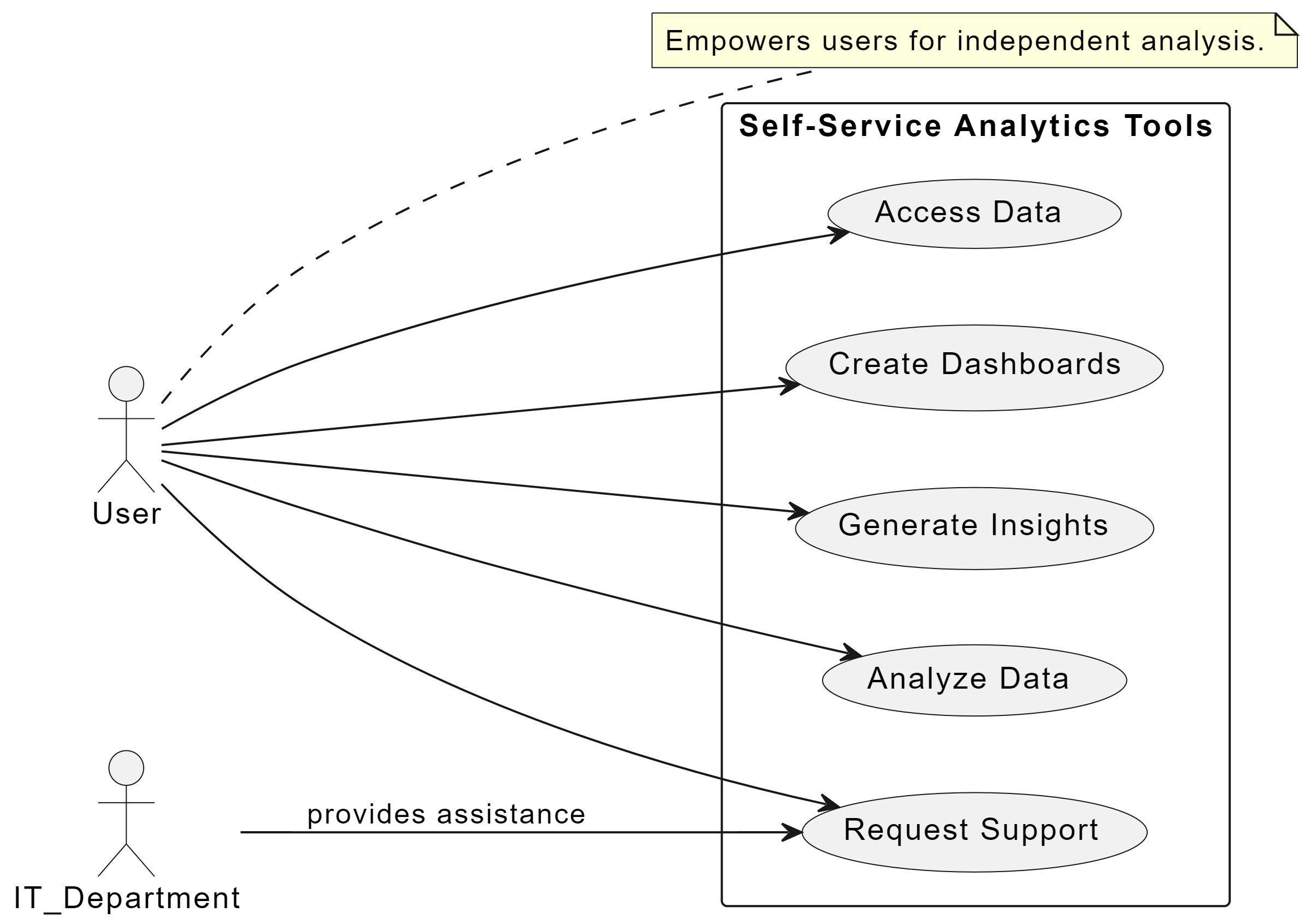
Some benefits of self-service analytics include:
Speed: Users can quickly access and manipulate data, allowing quicker decision-making.
User Empowerment: Business users can manage their datasets, promoting independence.
Cost Effective: Reduces the need for specialized data analysts, saving costs.
As Mike Pendleton, founder of The AI Cowboys, stated, “People lie, but the data never does.” With self-service analytics, you rely on data rather than assumptions.
3. Emergence of Hyper-Personalized AI Applications
Hyper-personalization takes personalization a step further. It utilizes AI to tailor experiences uniquely for each user. From marketing to customer service, hyper-personalized applications can adapt to individual preferences. Have you ever felt like an ad was speaking directly to you? That’s hyper-personalization at work.
Some examples include:
Retail: Brands like Amazon offer personalized recommendations based on browsing history.
Healthcare: Apps can suggest health plans tailored to individual health conditions.
Banking: Financial services predict and offer solutions based on spending habits.
These tailored experiences make users feel valued and understood. It’s all about engagement, isn’t it?
4. The Continuous Evolution of AI Methodologies
AI is not static; it’s a dynamic landscape. Every year unveils new methodologies, enhancing AI capabilities. Techniques like deep learning and neural networks keep evolving. Innovations lead to more robust solutions and increased efficiency.
Think about it like a constantly updated smartphone. Each version brings new features, enhancing user experience. In AI, methodologies improve algorithms continuously to solve complex problems.
Continuous evolution creates opportunities for businesses to leverage AI advancements. You can stay ahead by embracing these new methods.
5. Industry Expert Forecasts on AI Advancements
The future of AI is bright, but what do the experts predict? Mike Pendleton emphasizes collaboration and ongoing education. He believes that organizations should “foster an environment where people can share insights.” This collaboration is essential for growth.
Here are some expert forecasts:
Increased Automation: More tasks will be automated, freeing up human resources for strategic roles.
Ethical AI: Greater focus will shift toward creating ethical AI, addressing biases within systems.
AI in Everyday Life: Expect AI to integrate more seamlessly into daily activities, making tasks easier.
These trends indicate an exciting future not just for businesses but for consumers as well. With AI’s integration into our lives, the question becomes, how can you prepare for these changes?
Ultimately, staying informed and actively engaging with emerging technologies can enhance your skills. Are you ready to embrace the future of data and AI?
Conclusion
The integration of data and AI is crucial for businesses in the coming years. Predictive analytics helps foresee trends, while self-service tools give you immediate access to insights. Hyper-personalized applications cater to individual needs, making consumers feel valued. The continuous evolution of AI methodologies ensures that businesses adapt to a changing landscape. Finally, industry expert forecasts spotlight the importance of ethical collaboration in the growth of AI technology.
In this dynamic environment, you can position yourself for success by fostering a culture of learning. Embrace collaboration and stay ahead of the trends. This journey into the future of data and AI is not just exciting but essential for personal and professional growth. Engage, learn, and prepare for what lies ahead—because the future is here, and it's data-driven.
